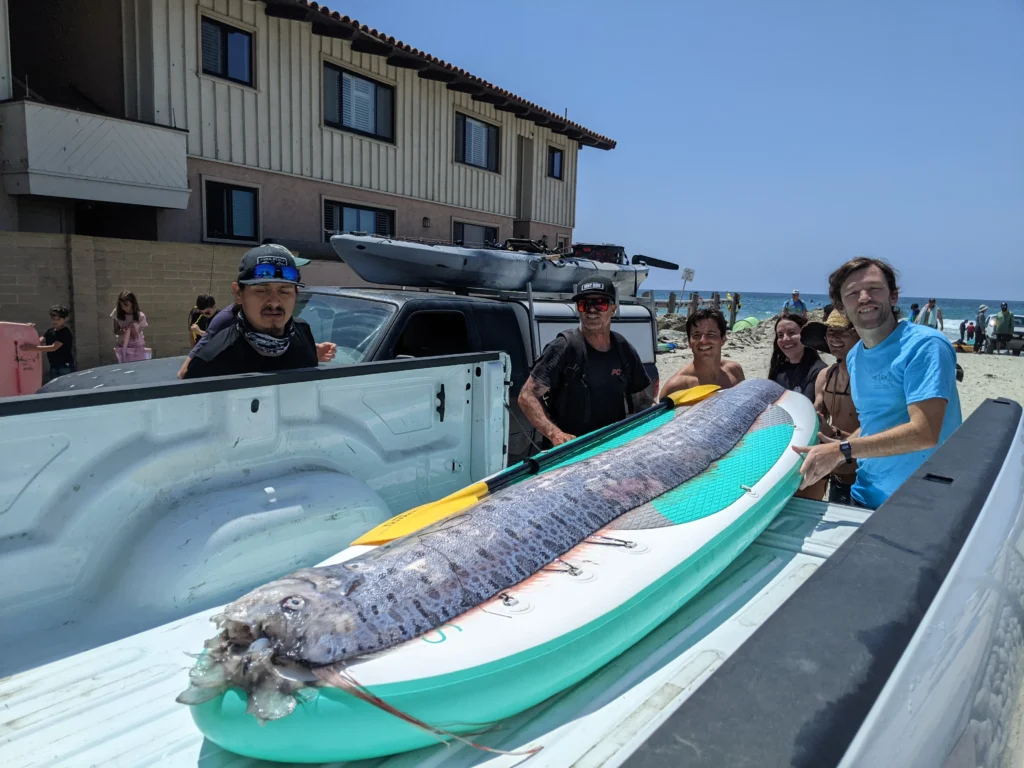doomsday fish: might sound like something straight out of a science fiction novel or an apocalyptic prophecy, but in reality, it refers to a very real phenomenon linked to certain species of deep-sea fish. These creatures have fascinated scientists, inspired legends, and even sparked fears among coastal communities. But what exactly is the Doomsday Fish, and why does it carry such an ominous name?

What is the Doomsday Fish?
The term “Doomsday Fish” is often used to describe the oarfish (Regalecus glesne), a mysterious deep-sea fish that can grow up to 36 feet long, making it the longest bony fish in the world. The oarfish is known for its elongated, ribbon-like body and its ability to live at extreme depths, often between 200 to 1,000 meters below the surface.
Despite its size, it is a relatively harmless creature, feeding mainly on plankton and small fish.
The Oarfish: Harbinger of Doom?
The connection between the oarfish and doomsday prophecies likely stems from its elusive nature and the circumstances under which it is often found. The oarfish usually lives far from shore, deep in the ocean, and rarely comes to the surface. However, when it does, it is often during unusual events such as earthquakes or storms, which can drive the fish closer to shore.
Throughout history, sightings of the oarfish have been associated with natural disasters, particularly earthquakes and tsunamis. In Japanese folklore, the oarfish is known as the “Messenger from the Sea God’s Palace,” and its appearance is believed to be a warning of impending earthquakes.
This belief was reinforced in 2011, when several oarfish were found washed ashore in Japan shortly before the devastating Tōhoku earthquake and tsunami.
Scientific Explanations
While the idea of the oarfish as a harbinger of doom is deeply rooted in folklore, scientists have proposed more rational explanations for its behavior. Some researchers believe that oarfish may be more sensitive to seismic activity than other marine species.
This heightened sensitivity could cause them to swim to the surface when they detect disturbances in the Earth’s crust, such as those caused by underwater earthquakes.
However, there is no conclusive scientific evidence linking oarfish sightings directly to seismic events. The rarity of these sightings makes it difficult to gather enough data to confirm any definitive patterns. Most scientists agree that while the oarfish’s appearance might coincide with certain natural disasters, it is unlikely to be a reliable predictor of such events.
Other “Doomsday Fish”
While the oarfish is the most famous of the so-called “Doomsday Fish,” other deep-sea creatures have also been given this ominous label. For instance, the giant squid and goblin shark are sometimes included in this category due to their rare and frightening appearances.
These creatures are often misunderstood and viewed with a mix of fear and fascination, especially when they wash ashore or are caught by fishermen.
The Role of Media and Pop Culture
The idea of the Doomsday Fish has been further popularized by media and pop culture, often with sensationalist headlines that play on people’s fears of the unknown. Documentaries, news reports, and even social media posts frequently depict the oarfish as a creature from the deep that signals the end of times, adding to its mythos.
Conservation and Respect for Deep-Sea Life
Despite the ominous nickname, the oarfish and other deep-sea creatures play crucial roles in their ecosystems. These species are adapted to life in some of the most extreme environments on Earth, and they contribute to the biodiversity of the oceans.
Conservation efforts are important to ensure that these mysterious creatures are protected from threats such as deep-sea fishing, pollution, and climate change.
Conclusion
The Doomsday Fish, particularly the oarfish, is a fascinating example of how mythology, science, and the natural world intersect. While the idea of a fish predicting natural disasters is more myth than reality, the oarfish’s rare appearances and mysterious nature continue to captivate our imagination.
As we learn more about the deep-sea environment and its inhabitants, the stories of these creatures remind us of the vast, uncharted territories that still exist in our oceans—and the mysteries that lie beneath the surface.
